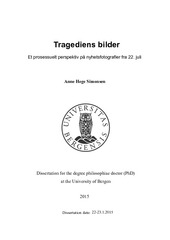Tragediens bilder: Et prosessuelt perspektiv på nyhetsfotografier fra 22. juli
Doctoral thesis

Åpne
Permanent lenke
https://hdl.handle.net/1956/15570Utgivelsesdato
2015-01-23Metadata
Vis full innførselSamlinger
Sammendrag
This thesis discusses the photojournalistic coverage of the 22. July 2011 events in Norway as a social drama inspired by Victor Turner’s studies of rituals and rites of passage. Turner’s model, which explores how human societies address crises, differentiates between four phases of a crisis: breach, conflict, redressive action and reintegration/schism. The 22. July events are accordingly studied through empirical material (news photographs in print) throughout its different phases. The thesis is also motivated by the question of what the news photographs does, as active agents – with reference to Elizabeth Edward’s analytical approach to photography. Arguing against understandings of photographs which limits their meaning through contextual analysis, Edwards calls for approaches with potential to grasp them in their active, creative capacity. By thus observing the news photographs in use, and through what Edwards calls their social biography, the thesis concludes that news not only form part in a number of varying contextual relation, they also perform different tasks. They document, explain, establish and criticize. They do not work as passive illustration, but take active part in different kinds of visual/textual interplay. Furthermore, through the conceptualizations of art historian Michael Baxandall, the thesis states that the news photograph works through its respective charge (the photographers task in a general sense) and brief (the specific situational demands)– as well as its broader cultural or contextual anchoring, troc. A terrorist action committed at a time of peace will always generate shocks. The action may in itself be characterised as a breach, a change of paradigm or a point of no return. The thesis argues however that the news photographs from 22. July do not form coherent narratives. They rather come across as fragments – and thus, as discussed in chapter 1-3, form a kind of pre-narrative situation. When events are unclear, the visual narrative takes on the same kind of indecisive character. This does not have anything to do with the professional capacity of the photographers or the images as such, but rather the demands of the situation. The photographers were merely aiming to document the physical destructions on human bodies and on buildings. The photographs in this way formed fragment or bits of a bigger puzzle of which the larger picture still could not be grasped. In the following phases the photographs contributed to establishing partly conflicting narratives that could give the event meaning and direction to the responses of the Norwegian society. This phase is discussed through close readings of two particular images which both became focal points of political attention after 22. July. The first is Tommy Ellingsen’s awarded photograph of prime minister Jens Stoltenberg embracing AUFleader Eskil Pedersen by Sundvolden hotel just a few hours after the shooting at Utøya, and the second, a still-life photograph taken from an amateur video recording which shows the special force of the police in a sinking rubber-boat while unsuccessfully trying to reach Utøya. The thesis argues that while the first image contributed to building the personal authority of the prime minister, the second on the contrary worked to undermine the trust in the system he represented. Other images, as the photographs of the “carpet of flower” outside the Oslo Cathedral, as discussed in chapter 4, contributed to constituting an extraordinary sense of communitas – and were later in this capacity transported from the arena of journalism into the “higher” sphere of national emblems. Furthermore the thesis demonstrates how the photographic material manifests different ways of understanding the character Anders Behring Breivik, respectively as a criminal or an evil manipulator (chapter 6). In the last phase of redressive action however, the news photographs seem to be used in a more conceptual manner – as demonstrated in a close comparative reading of a number of front pages (chapter 7). The thesis finally also demonstrates and discusses the different uses of photographs Norwegian and international news media covering the event. The 22. July 2011 was a sensitive matter by which many people were affected. The discussion about whether the media contributed to the thoughtless iconization of Breivik also became a media event in itself. In connection with the trial many papers reflected a more nuanced understanding of this problem. Some papers attempted to limit the use of, or avoid photographic representations of his face – others came up with more conceptual ways of visualization. The last chapter of the thesis demonstrates how the photographic representation of the event in its last phases and in the aftermath has entered new spaces – primarily of the kind where priority is given to processes of recognition, contemplation and memory.